Notes on the space tracking activities and
sensational claims made by the Judica-Cordiglia brothers
Sven Grahn
The claims made by the
Italian brothers Achille and Gian Battista Judica-Cordiglia of having
tracked
Soviet spacecraft with cosmonauts onboard that perished are well known
and lately described in some details at the "Lost
Cosmonauts" web site (discovered to be defunct in October 2013) set up by Giovanni and Mario Abrate. The
stories
of the Judica-Cordiglias sensational intercepts are part of the
mythology
of the Space Age. Serious students of space history such as James Oberg
have thoroughly debunked (4) these claims.
Here I just would add some notes in support of such debunking and also
to provide some details about the operation of the Judica-Cordiglias
located
outside Turin in northern Italy. Some material comes from the
"Lost
Cosmonauts" site while other material comes from my own files.
Analysis
of the information provided at the "Lost Cosmonauts" web site
Pictures
Let me state initially that
I do not think there is any truth in the wild claims of the
Judica-Cordiglia
brothers. However, the brothers at their tracking station in Turin ran
a tracking post that seems reasonably well equipped. At the "Lost
Cosmonauts"
web site there are several pictures of the brothers and their
equipment.
Below you will find them or parts of them and my comments to what we
can
see in them. The photographs are published here through the kind
concession
of the "Lost Cosmonauts" website.

In this picture we
see the
main tracking antenna at Torre Bert. The "dish" actually seems to be a
rather flat reflector, in effect a "ground plane". there are six Yagi
antennas
mounted over this ground plane and if they are fed in phase they
provide
a 7.8 dB gain increase over the single Yagi. In other pictures there is
a single helix at the center of the ground plane.
If one looks
carefully it
is possible to see that each concentric octagonal frame forming the
reflector
is mounted a little further our from the supporting booms as one
approaches
the edge. This may have been a rough approximation of a parabolic dish,
but with the Yagis in the picture above, this would have had no, or
very
little effect on gain.
In the
configuration above
only the number of Yagis and the way they are fed is important. The
"dish"
in this case works as a (oversized) ground plane!
The azimuth steering of this antenna seems to
have been done manually and I guess that the wheel seen just above the
man's head in the picture on the right is the "steering wheel" for the
antenna!
|
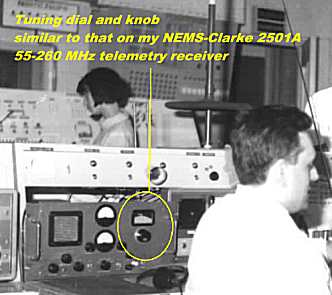
This radio seems to have a loudspeaker on the
left side and a tuning knob and dial very similar to that of my
Nems-Clarke 2501 A 55-260 MHz telemetry receiver (see
below)
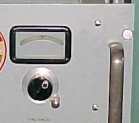
|
The
interview
with Gian Battista Judica-Cordiglia
This interview is a
remarkable
piece of text - really strange in many respects. Mr. Gian Battista
Judica-Cordiglia
(abbreviated GJC below) both makes strong and definite claims, gives
technical
details about equipment and intercepts, but his story is hollow indeed,
I think.
-
He describes how the
signals
they received on 28 November 1960 could have come from a space vehicle
moving away from earth on an escape trajectory and that it had done so
because the retrorockets had fired in the wrong direction. First,
retrorockets
normally provide a velocity increment in the order of 100 m/s.
The
retro-rocket of the spaceship that he says they tracked in November
1960
was supposedly to have provided 11.2-8=3.2 km/sec of velocity
increment.
The rocket equation [dV= w * ln(r), where dV is the velocity increment,
w is the exhaust velocity -assumed to be 2.7 km/s and r is the mass
ratio]
shows that a mass ratio of 3.3 would be needed, i.e. the spacecraft
would
have had to carry more than twice its dry mass as propellant! If the
spaceship
that the Judica-Cordiglias say they heard is anywhere near Vostok in
dry
weight, then the whole vehicle must have weighed more that 13 tons in
orbit
- clearly outside the capability of the Vostok booster. Also, he says
that
they heard Doppler shift. This is very hard to detect from a vehicle
moving
away from earth very far from earth. The radial velocity varies very
little,
so the signal frequency varies very little. On a low frequency like 20
MHz, where the purported reception was probably made, the shift is
indeed
small. The arguments put forward by GJC may impress the technically
ignorant,
but not someone with the most basic knowledge of space technology.
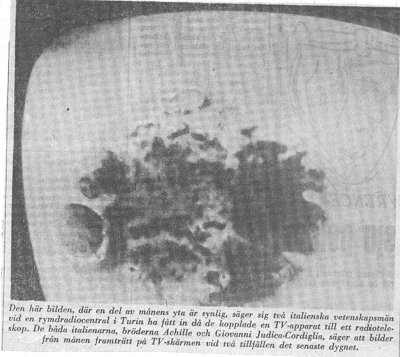 Then
follows a really extraordinary series of statements. First GJC mentions
the frequencies that the antenna was used for: 108 MHz (OK, used by
early
U.S. satellites and space probes), 137 MHz (a well-established space
radio
band), 145.800 MHz (Only used by radio amateur satellites as far as I
know)
and 405 MHz (never heard about that frequency being used for space
vehicles).
He then goes on to say that Soviet Kosmos satellites broadcast pictures
on 145.800 MHz and that they had been directed towards Baikonur. This
is
indeed strange - if I hear a signal from space how can I know where the
ground stations is? GJC then goes on to say that the pictures showed a
U.S. long-range bomber in New Mexico! And that the pictures that Torre
Bert received were confiscated by Italian intelligence .... very
inconvenient
for latter-day analysts .... the proof is gone! We know that early
Zenit
reconnaissance satellites (Kosmos-4, -7, -9, and -13) carried an
imaging
system that sent facsimile-type pictures to the ground, but they were
of
poor quality and were received on 163 MHz (1).
In my humble opinion one couldn't possibly see a bomber! The system was
discontinued in favour of the film return system. However, I have been
in contact with GJC through Giovanni Abrate and he maintains that
the frequency ws 145.8 MHz and that Italian intelligence was involved.
Then
follows a really extraordinary series of statements. First GJC mentions
the frequencies that the antenna was used for: 108 MHz (OK, used by
early
U.S. satellites and space probes), 137 MHz (a well-established space
radio
band), 145.800 MHz (Only used by radio amateur satellites as far as I
know)
and 405 MHz (never heard about that frequency being used for space
vehicles).
He then goes on to say that Soviet Kosmos satellites broadcast pictures
on 145.800 MHz and that they had been directed towards Baikonur. This
is
indeed strange - if I hear a signal from space how can I know where the
ground stations is? GJC then goes on to say that the pictures showed a
U.S. long-range bomber in New Mexico! And that the pictures that Torre
Bert received were confiscated by Italian intelligence .... very
inconvenient
for latter-day analysts .... the proof is gone! We know that early
Zenit
reconnaissance satellites (Kosmos-4, -7, -9, and -13) carried an
imaging
system that sent facsimile-type pictures to the ground, but they were
of
poor quality and were received on 163 MHz (1).
In my humble opinion one couldn't possibly see a bomber! The system was
discontinued in favour of the film return system. However, I have been
in contact with GJC through Giovanni Abrate and he maintains that
the frequency ws 145.8 MHz and that Italian intelligence was involved.
-
GJC also mentions that
the Torre
Bert stations received pictures of the Moon from Luna-4. I have an old
newspaper clipping from 1963 with a picture of the moon distributed by
the Torre Bert station and said to have been received from the Soviet
Luna-4
spacecraft. Above right you can see a scanned copy of this clipping (In
the scanned image you can also see the back of the thin newspaper
page..).
The picture
caption
is in Swedish, but reads "This picture of the lunar surface is said
to have been received by two Italian scientists at a space radio center
in Turin when they connected a TV set to a radio telescope. The two
Italians,
the brothers Achille and Giovanni Judica-Cordiglia, say that pictures
from
the Moon have appeared on the TV screen on two occasions during the
past
24 hours."
We know from
other
intercepts of Luna spacecraft that images were transmitted by very low
speed facsimile similar to the type used by the APT transmitter on
weather
satellites. Such pictures have been reproduced on telephoto machines in
the past and nowadays by software running on PCs. When I saw this
picture
I sincerely doubted that a TV hooked up to receiver tuned to the Luna-4
frequency would produce anything but noise.
To find out more I
contacted
Giovanni Abrati who relayed the following explanation from GJC : "The
Moon pictures were transmitted in slow-scan, recorded on audio tape and
re-composed using a TV monitor and a camera set to 'B'." This
makes
sense technically and I have asked GJC to confirm that the signals were
received in the 183 MHz band normally used by Luna probes.
However, the "Moon picture"
reproduced in the newspaper clipping looks very much retouched. It would be
quite interesting if the "Lost Cosmonauts" web site could also publish the
pictures said to have come from Luna-4. A disturbing fact is that I have
nowhere found any evidence that stations like Jodrell Bank or the NRL ground
station in Maryland with its 45-m dish picked up these pictures (Check my
Jodrell Bank
articles). In
addition, as far as I have been able to ascertain, there have been no signs of
images having been transmitted during the approach to the moon by the E-6
Lunar probes, only after landing.
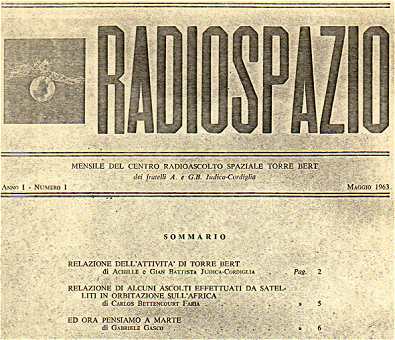 The
publication "Radiospazio" and its description of radio intercepts
The
publication "Radiospazio" and its description of radio intercepts
I have photocopies of the
publication
"Radiospazio", issues 1 and 2 dated May and June 1963 (2)
published by the Judica-Cordiglias in which the tracking activities of
the Torre Bert tracking station are described (See reproduction of the
cover of issue 1 on the right. Click on the picture of the cover to see
the entire cover and its table of contents).
The first issue gives a
summary
of the activities of the Torre Bert operation. Using my limited
knowledge
of Italian, I have been able to make out the following:
-
Sputnik 1 was received
on a
U.S. war surplus receiver and an antenna "rotativa" (A rotating HF
beam?)
and then Sputnik 2 and 3 were also picked up from a "cantina" in Via
Academia
Albertina
-
The voice of Gagarin
was picked
up and recorded! I asked Giobvanni Abrate about this and he explained
that
"Gagarin's
voice was recorded following a message from the Italian state press
agency,
coming from Moscow and indicating ongoing space activity. For two days,
the Judica Cordiglia brothers manned their receivers, waiting for
signals
in the 19.995-20.005 MHz band." This makes sense.
-
The Geloso radio
company donated
equipment (yes, I recognize their typical tuning dials in some of the
pictures
from Torre Bert).
-
There was a mobile
tracking
station carried in a car of the type "Leoncino"
The sensational reports
about
failed Soviet space mission are numerous, but here are the main reports:
-
On 28 November 1960
the Morse
code message "SOS to the whole world" from a spaceship in trouble was
picked
up
-
Heartbeats and forced
breathing
from a dying cosmonaut picked up in the 2-4 February 1961 time frame
-
Signals from a space
vehicle
in trouble picked up 16-19 May 1961.
-
Female voice picked up
picked
up on 14 June 1963 at 2104 (CET?). Torre Bert claims that Valentina
Tereshkova
was launched two days prior to what the Soviet Union stated.
-
Torre Bert picked up
traffic
from what they say were Soviet ground stations related to the space and
missile program in the 6 September 1962 and 17-20 November 1962
periods
that they say indicated an "imminent Soviet space launch". (Failed
Soviet
Venus probe launched on 12 September and a Soviet Mars probe failed on
24 Oct 1962)
-
Torre Bert picked up
signals
that indicated that a Soviet space vehicle was in orbit during the time
8-12 November 1962
In particular the radio
intercepts
of heartbeats and heavy breathing from a dying cosmonaut are described
at length in the June 1963 issue. From the text alone it is virtually
impossible
to form any opinion about these radio intercepts. Therefore I am glad
that
the Abrates have been able to publish (on the Web) the sound files from
these much discussed radio intercepts. In this way everyone can judge
for
himself the quality of the radio intercepts and their credibility.
As far as I can tell
from
the "Radiospazio" issues, the "heartbeat" and "heavy breathing" files
were
recorded at 2255 (Central European Time?) on 2 February 1961.
However, even the "Radiospazio" issues contain very sketchy logs of these and
other receptions and vague data as to reception frequencies ("around [intorno
ai] 20 MHz"). Concerning the "breathing" and "heartbeat" signals I would like to
note that heart rate and breathing was never transmitted directly on the
Vostok/Voskhod voice link. Instead this data was transmitted in the way
described at my Web site (
"Biomedical telemetry"
). (You can hear
the
heartbeat of Valery Bykovsky as interruptions in the CW signals
from Vostok-5). A key question is: Why would the failed flights use
a different transmission system compared to the successful ones?
Much later, at the end of the
70's,
electrocardiogram
signals were transmitted on the Salyut 6
voice link, but then the signal was easily recognizable as
ECG.
The file with the
female
"cosmonaut's" voice recorded during the period 16-19 May 1961 (dates vary, sometimes the period is given as 16-23 May 1961) is so
garbled that it is virtually impossible to make out individual words. Compare
this to the sound file with
the voice of Vladimir Komarov
at my Web site and you shall understand why I think the Torre Bert sound file
has no value at all as evidence of anything!
More
pictures
from Torre Bert
In my files I have Xerox
copies
of more pictures from Torre Bert that I have reproduced below. What you
see from these pictures is an ambition to create an impressive-looking
environment with devices such as wall-screens for displaying satellite
position.
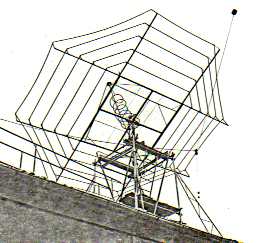
Here is another picture of the main tracking
antenna with single helix as the driven element and no sign of the six
Yagis in the other picture
|
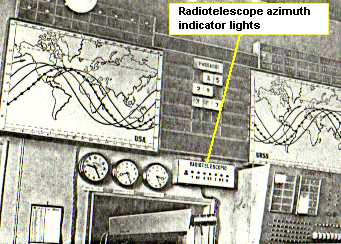
The wall
displays are somewhat confusing. The "USA" display shows an
approximately i=50 deg orbit out of the Cape. Such launches took
place in the early days, but were indeed unusual. The "URSS" display shows
and obit at i=60 deg instead of the standard 65 deg inclination.
Just sloppy work? There are indicator lights along the orbit closest to
Italy that probably could be lit to show the motion of the satellite. I have
added an
explanation of the display next to the clocks.<
/EM>
|
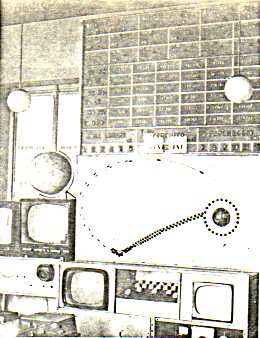
Another impressive-looking display, this time of
a lunar trajectory, seemingly based on the Luna-3 trajectory. Indicator
light could show the position of the spacecraft. There is a status display
and just below the left ceiling light there is the text "Parcheggio", i.e
"Parking", probably to indicate the probe was still in parking orbit. The
position display seems also to have the ability to display a parking
orbit. The usufelness of this device is highly dubious, but it looks
"cool"
|
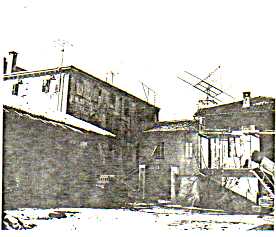
An overall view of the building at Torre Bert.
The main antenna is visible as well as three antennas on the adjacent
building. The antenna on the right corner of the adjacent building has
four vertical members (hard to see in the picture
above)
|
Conclusions
I think that the
Judica-Cordiglia
brothers did run a tracking station and picked up signals from various
spacecraft. However, for some reason they thought that they needed
sensational
stories maintain their image of a "hot-shot" operation. Once they
over-interpreted
some receptions and made fantastic claims they were "trapped" and had
to
continue to produce sensations.
Another interesting
fact
related by Giovanni Abrate (one of the authors of the "Lost Cosmonauts"
site) is found in his comment that (3):
"What is difficult
to
understand for those who did not live through these events in Turin, is
that Torre Bert very rapidly became a center of media attention. Many
of
the relevant intercepts were actually made in the presence of national
and international media. Some of Italy's most respected journalists
'lived'
at Torre Bert, shared the Judica Cordiglia family's meals, in order to
be present when the transmissions were intercepted. The US Vice-Consul
in Turin provided intelligence and advance warning of possible
impending
soviet launches."
So, the presence of
journalists
may explain some of the claims. Journalists need to deliver stories to
their editors. They cannot spend long hours at a "tracking station" and
not report anything that sounds substantial......
The psychological
mechanism
is similar to that displayed by the Bochum observatory in Germany that
also regularly over-interpreted the signals they heard in order to grab
headlines. The Bochum operation needed support from sponsors and it
seems
that headlines was a way of getting continued financial support.
However, the Bochum observatory never reached the extreme heights of
fantasy
that the Judica-Cordiglia brothers (or the reporters that surrounded
them)
achieved.
In general the
Judica-Cordiglias
never seemed to understand that extraordinary claims require
extraordinary
evidence to be believed. They never have produced such
extraordinary
evidence..details about reception frequencies, log books etc.. The
recordings
published on the "Lost Cosmonauts" website is an improvement in this
respect,
but unfortunately these recordings do not impress.... . It is also a
pity
that details of receptions by the Judica-Cordiglia brothers of more
"hum-drum"
satellites are not easily available. This could help in evaluating
their
credibility by cross-checking their reports with those of other
satellite
trackers.
In summary, the
sensational
stories that were put our by the Judica-Cordiglia brothers and how they
have been propagated through the years are interesting as a social
phenomenon
- how myths begin and self-perputate themselves..!
Postscript 3 August 2008
I
have now looked at the documentary about the Judica-Cordiglia brothers available
on YouTube
http://www.southgatearc.org/news/july2008/space_hackers.htm). It is of course, the same old story, but very well told
by the filmmakers. However, there is nothing that convinces me. The heartbeats
and strange radio calls we have heard before - nothing new at all. However, a
few more details are given about the recording of Gagain's and Glenn's
voices.
Tracking Gagarin
Now they say they were tipped off about and
imminent manned launch on 12 April 1961. They could have listened on 20.005 MHz
which was used by the Sputniks. The AM voice from Vostok 1 was transmitted on
20.006 MHz and 9.019 MHz according to the TASS news release. So, in principle,
they could have picked up Gagarin. What makes me a bit suspicious is the
recording played in the documentary. It sounds awfully like the voice recording
released by the Soviet Union at that time - and available on a EP record.
See:
How good was the original recording made by the
brothers? Was it really Gagarin? There was plenty of ground-based Russian AM
voice in the 19.995-20.005 MHz band in those days.
Tracking Glenn
Now they say they measured the HF whip antenna used during recovery
operations to figure out the frequency used by Glenn. This is interesting. The
HF telescoping whip antenna deployed during recovery served both the HF AM voice
on 15.016 MHz and the recovery beacon on 8.364 MHz (Check the
Mercury Familiarization Manuals
). This makes it dubious whether it is possible to determine the
frequency by measuring the length of the whip. There could have been all sorts
of devices to adapt the antenna to both frequencies. Also, the recording played
in the documentary is extremeley brief and it is barely possible to hear the
word "Mercury".
Tracking Explorer-1
There were no other recordings (except Sputnik 1) played in the
documentary that other people have heard. I woud have liked to hear signals from
spacecraft that sounds like the signals that other trackers have heard.
The signals from Explorer-1 were not convincing either. It was just a plain
carrier, while other trackers heard commutated subcarriers (See
http://www.svengrahn.pp.se/sounds/spectrgr/spectra.htm).
Allt this is as confusing as it always has been.
The brothers say in the documentary that the loved to do "mischief" as young
men. Indeed! That is what I think they keep doing.
References
-
Henry
G. Plaster, "Snooping on Space Pictures", Studies in Intelligence,
RG 263, Entry 400, "Articles From Studies in Intelligence, 1955-1992",
National Archives and Records Administration.
-
RADIOSPAZIO,
Mensile del centro radioascolto spaziale Torre Bert de fratelli A. e
G.B.
Judica-Cordiglia, Issue 1:May 1963 and Issue 2:June 1963.
-
Giovanni
Abrate, e-mail to Sven Grahn, 16 January 2000.
-
Oberg,
James, "Phantoms of space", Part
1 and Part
2.

 Back
to "Space Tracking Notes"
Back
to "Space Tracking Notes"



 Then
follows a really extraordinary series of statements. First GJC mentions
the frequencies that the antenna was used for: 108 MHz (OK, used by
early
U.S. satellites and space probes), 137 MHz (a well-established space
radio
band), 145.800 MHz (Only used by radio amateur satellites as far as I
know)
and 405 MHz (never heard about that frequency being used for space
vehicles).
He then goes on to say that Soviet Kosmos satellites broadcast pictures
on 145.800 MHz and that they had been directed towards Baikonur. This
is
indeed strange - if I hear a signal from space how can I know where the
ground stations is? GJC then goes on to say that the pictures showed a
U.S. long-range bomber in New Mexico! And that the pictures that Torre
Bert received were confiscated by Italian intelligence .... very
inconvenient
for latter-day analysts .... the proof is gone! We know that early
Zenit
reconnaissance satellites (Kosmos-4, -7, -9, and -13) carried an
imaging
system that sent facsimile-type pictures to the ground, but they were
of
poor quality and were received on 163 MHz (
Then
follows a really extraordinary series of statements. First GJC mentions
the frequencies that the antenna was used for: 108 MHz (OK, used by
early
U.S. satellites and space probes), 137 MHz (a well-established space
radio
band), 145.800 MHz (Only used by radio amateur satellites as far as I
know)
and 405 MHz (never heard about that frequency being used for space
vehicles).
He then goes on to say that Soviet Kosmos satellites broadcast pictures
on 145.800 MHz and that they had been directed towards Baikonur. This
is
indeed strange - if I hear a signal from space how can I know where the
ground stations is? GJC then goes on to say that the pictures showed a
U.S. long-range bomber in New Mexico! And that the pictures that Torre
Bert received were confiscated by Italian intelligence .... very
inconvenient
for latter-day analysts .... the proof is gone! We know that early
Zenit
reconnaissance satellites (Kosmos-4, -7, -9, and -13) carried an
imaging
system that sent facsimile-type pictures to the ground, but they were
of
poor quality and were received on 163 MHz ( The
publication "Radiospazio" and its description of radio intercepts
The
publication "Radiospazio" and its description of radio intercepts


